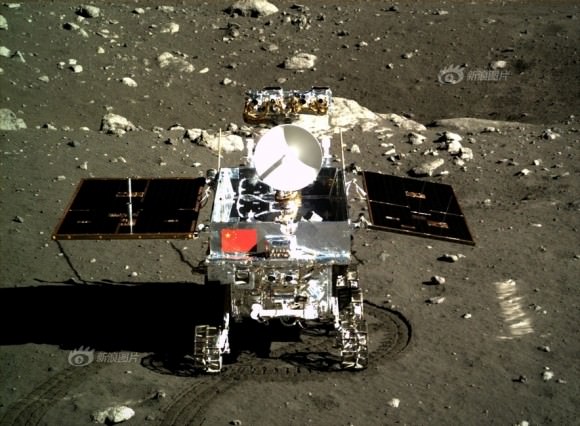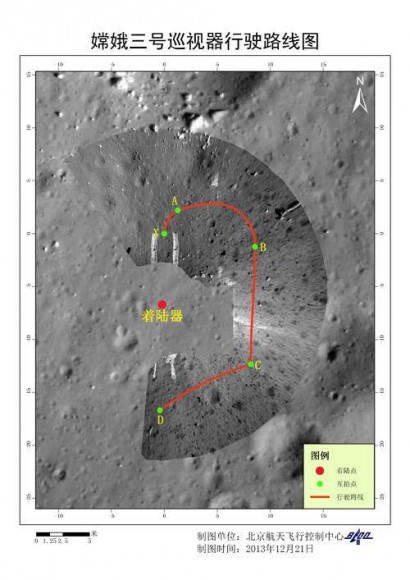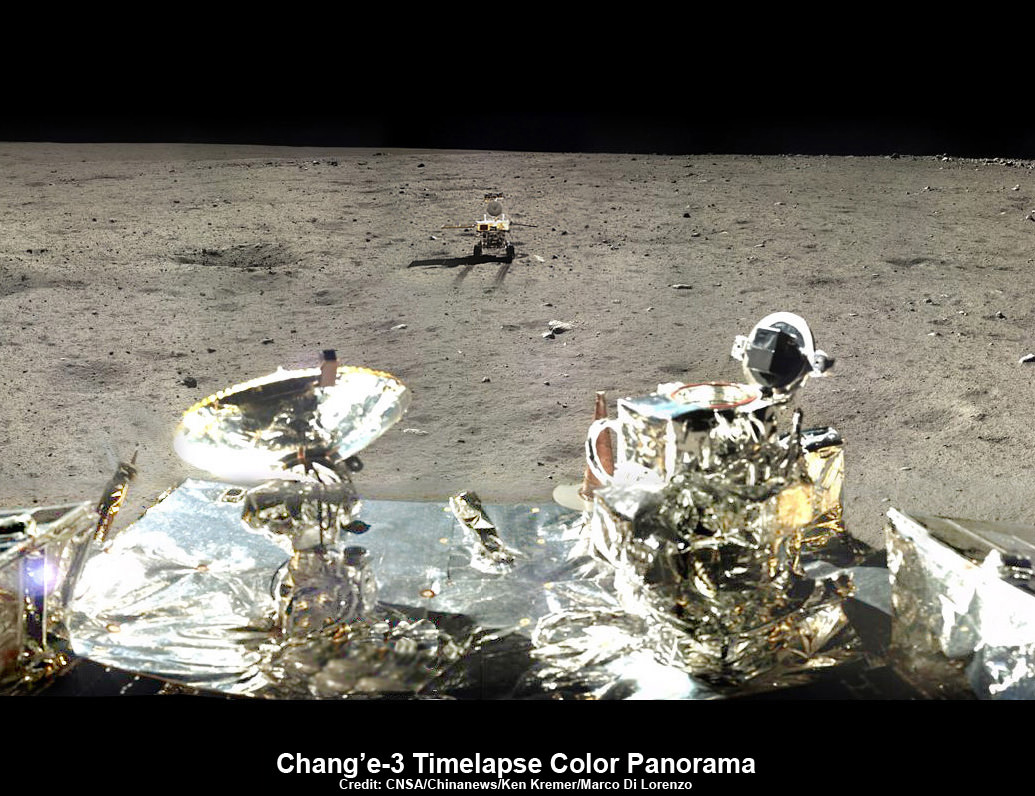China’s maiden moon rover ‘Yutu’ has just suffered a significant mechanical setback right at the start of her 2nd lunar night, according to an official announcement from Chinese space officials made public this weekend.
The six wheeled Yutu rover, which means ‘Jade Rabbit’, has “experienced a mechanical control abnormality” in a new report by China’s official government newspaper, The People’s Daily.
‘Jade Rabbit’ was traversing southwards from the landing site as the incident occurred just days ago – about six weeks into its planned 3 month moon roving expedition.
However very few details have emerged or been released by the Chinese government about Yutu’s condition or fate.
“Scientists are organizing repairs,” wrote the People’s Daily.
The abnormality occurred due to the “complicated lunar surface environment,” said the State Administration of Science, Technology and Industry for National Defence (SASTIND) in a brief statement, without giving further details, according to the paper.
This situation is very serious because the “abnormality” took place just prior to the beginning of the 2nd lunar night and unavoidable ‘dormancy’ for both ‘Jade Rabbit’ and the Chang’e-3 mothership.
So it’s not clear at this time if Chinese space engineers were able to take any concrete actions to rectify the unspecified problem before both spacecraft entered their next two week long night time slumber.
Based on unofficial accounts, it appears that one of the solar panels did not fold back properly over Yutu’s mast after it was lowered to the required horizontal position into a warmed box to shield and protect it from the extremely frigid lunar night time temperatures.
That could potentially spell doom for the mast mounted instruments and electronic systems, including the color and navigation cameras and the high gain antenna, if true.

The now world famous rover entered its second hibernation period at dawn on Saturday, Jan. 25, as the lunar night fell, according to the SASTIND statement.
The mothership “fell asleep” a day earlier on Friday, Jan 24.
Each ship had just completed their 2nd Lunar Day of operations and had apparently been functioning normally and taking planned scientific measurements and imagery.
The research program during Lunar Day 2 included optical telescope observations of the sky, extreme ultraviolent (EUV) observations of the Earth’s plasmasphere, subsurface radar measurements, and spectroscopic measurements with Yutu’s robotic arm.
Both vehicles depend on their life giving solar panels to produce power in order to function and accomplish their scientific tasks during each Lunar day which lasts approximately 14 days.
Likewise, each Lunar night also lasts approximately 14 Earth days.
In order to survive into the next Lunar day, they must each endure the utterly harsh and unforgiving lunar environment when the Moon’s temperatures plunge dramatically to below minus 180 Celsius, or minus 292 degrees Fahrenheit.
So they must enter a sleep mode to conserve energy since there is no sunlight to generate power with the solar arrays during the lunar night.

This 360-degree time-lapse color panorama from China’s Chang’e-3 lander shows the Yutu rover at three different positions during its trek over the Moon’s surface at its landing site from Dec. 15-22, 2013 during the 1st Lunar Day. Credit: CNSA/Chinanews/Ken Kremer/Marco Di Lorenzo – kenkremer.com
During the nocturnal hiatus they are kept alive by a radioisotopic heat source that keeps their delicate computer and electronics subsystems warmed inside a box below the deck. It must be maintained at a temperature of about minus 40 degrees Celsius to prevent debilitating damage.
In a historic first for China, the Chang’e-3 spacecraft safely touched down on the Moon at Mare Imbrium near the Bay of Rainbows some six weeks ago on Dec. 14, 2013.
Seven hours later, the piggybacked 140 kg Yutu robot drove off a pair of ramps, onto the Moon and into the history books.
Is it Farewell Forever Yutu ??
We don’t know yet.
And since there is no communication possible during sleep mode, no one will know until the resumption of daylight some two weeks from now – around Feb. 8 to 9.

Whatever happens, China can be proud of their magnificent accomplishment with the Yutu rover and the 1200 kg stationary Change’-3 lander which has reinvigorated lunar surface exploration after a nearly 40 year gap.
And we wish China’s scientists and engineers well !
China is only the 3rd country in the world to successfully soft land a spacecraft on Earth’s nearest neighbor after the United States and the Soviet Union.
Meanwhile as we await the fate of China’s Yutu rover trundling across pitted moonscapes, NASA’s Opportunity rover is in the midst of Martian mountaineering at the start of Decade 2 on the Red Planet and younger sister Curiosity is speeding towards the sedimentary layers of Mount Sharp.
Stay tuned here for Ken’s continuing Chang’e-3, Orion, Orbital Sciences, SpaceX, commercial space, LADEE, Mars and more news.


Bummer… I hope they find an easy fix…..
Sci-Fi short story subject: The Change’-3 lander did not overshoot the intended landing zone. Instead it landed exactly where intended. Recently this area has provided evidence of unknown surface activity. Clouds of dust and gas have been seen rising above a nearby crater. Insiders posited this may be evidence for volcanic out-gassing? LRO camera’s will continue to track the rover.as the orbit allows.
Update – In the last series of oblique observation passes the rover was not seen. When the space craft finally reached the right orbital position for imaging, a new crater was seen at the calculated rover location.
Update – :LRO has gone into safe mode and data are temporarily unavailable.
All learning experience for the Chinese space administration. The moon dust probably didn’t help. That stuff gets every where and jams up the works.
The elephant in the room of a Lunar Colony is that dust getting into ventilation and the long term effects on the filtering system and breathing it.
I wonder why the rover tracks just kind of trail off into nothing a couple of meters behind it.
any theories? lunar wind blowing the regolith? hehehe 🙂 fancy schmancy photographic necessities that we don’t understand? who knows?
Lighting angle? Or praps the rover passed into an area where the underlying regolith/soils have a darker consistency or reflective/refractive index and is easily modified?
I wonder! interesting observation, unfortunately we will probably never know 🙂 Such is the nature of distance photography. As soon as you zoom in, you will start to see faces, telephones, power lines, you name it!
Well, it is a panorama photo. Knowing how panorama’s work, I would imagine that parts of those photos were taken before the rover have traveled over that area. Its not some fancy lighting, or once in a lifetime lighting angle. No, it is just the wonder of a time lapse panoramic picture.
I really love your articles, Ken, but the lines at the end of this one seemed a little ‘snarky’? Basically, ‘So after 3 weeks, China’s Moon Rover has quite possible died…. MEANwhile on MARS, the US’s Opportunity Rover has begun it’s SECOND DECADE of a three month Primary’……. LOL!
Space is tough on these little critters! Whatever happens, it will be an important learning opportunity for the Chinese on how to engineer these things and how to fix them in action.
Aliens have taken our “Yutu” just like my Chinese hair dryer, it worked well for 3 weeks and looked good then disappeared forever, please come back “Jade Rabbit” we miss you……
Jeff, I’m glad you like the article. But you have mischaracterized and misquoted the story.
here is exactly what I wrote about Yutu & Opportunity:
Whatever happens, China can be proud of their magnificent
accomplishment with the Yutu rover and the 1200 kg stationary Change’-3
lander which has reinvigorated lunar surface exploration after a nearly
40 year gap.
And we wish China’s scientists and engineers well !
Meanwhile as we await the fate of China’s Yutu rover trundling across pitted moonscapes, NASA’s Opportunity rover is in the midst of Martian mountaineering at the start of Decade 2 on the Red Planet
Hey Ken. I purposefully took your last lines out of context for comedic effect. I understand the accomplishment to be SURE! I am NOT a China hater or poo-pooer at all! Yes the Moon is quite harsher an evironment and I respect that deeply. Again, I just kid!
Idk, seeing as a very likely reason for this is China still being mad that we won’t let them join our ISS, or work with them at all for that matter, I dont have an extreme amount of respect for this. Was it a cool accomplishment, yes, but one done for a relatively unclear reason by a country known to do things such as claim lands that arent theirs and steal numerous technologies from around the world. I’m not saying that they are doing this for the wrong reasons, but it wouldn’t surprise me.
I think that loosing the mast instruments wouldn’t necessarily mean loosing the mission. It could navigate by the lander cameras, and I’m sure it has a low gain backup antenna. It could still run around its ground penetrating radar, which certainly is the most important instrument. The chassi has a radio isotope heater. If only the photovoltaics keeps generating some power, loosing the mast shouldn’t be the end of it all.
MADE IN CHINA
Mars does not have night that lasts for 14 Earth days at minus 180 degree Celsius. And Mars also does not have day-temperatures of 100 degree Celsius for 14 days.
we all thought it at least once, but no one wanted to say it 🙂
a terrible comment
K. K, dont stoop down into these types of comments 🙂 trust me, its for your own benefit as a writer here on UT haha. Probably not worthy of your attention. Keep yourself clear and free of these associations in readers’ minds, that way your articles keep a more scientific and disinterested feel because we don’t see you fraternizing with the commenters who could be anyone with an internet connection. Rock the info, teach us good. but don’t two word bash some dudes opinion, it only takes away from what you have written. nah mean?
An appropriate joke.